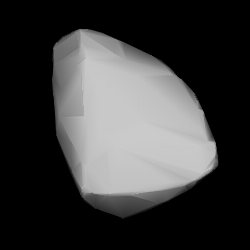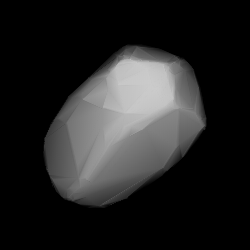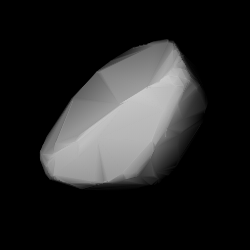Related Research Articles

3325 TARDIS is a dark Alauda asteroid from the outer region of the asteroid belt, approximately 29 kilometers in diameter. It was discovered on 3 May 1984, by American astronomer Brian Skiff at Lowell's Anderson Mesa Station, Arizona, in the United States. The asteroid was named TARDIS, after the fictional time machine and spacecraft from the science fiction television series Doctor Who.

1767 Lampland, provisional designation 1962 RJ, is an Eoan asteroid from the outer regions of the asteroid belt, approximately 15 kilometers in diameter. It was discovered on 7 September 1962, by astronomers of the Indiana Asteroid Program at Goethe Link Observatory in Indiana, United States. The asteroid was named after American astronomer Carl Lampland.
1128 Astrid, provisional designation 1929 EB, is a carbonaceous Astridian asteroid from the central region of the asteroid belt. It is the parent body of the Astrid family and measures approximately 40 kilometers in diameter.
1570 Brunonia, provisional designation 1948 TX, is a stony asteroid of the Koronis family from the outer regions of the asteroid belt, approximately 12 kilometers in diameter. It was discovered on 9 October 1948, by Belgian astronomer Sylvain Arend at the Royal Observatory of Belgium in Uccle. The S-type asteroid is likely elongated and has a longer-than-average rotation period of more than 48 hours. It was named for Brown University in Rhode Island, United States.
1707 Chantal, provisional designation 1932 RL, is a stony background asteroid from the Florian region in the inner asteroid belt, approximately 7.5 kilometers in diameter. It was discovered on 8 September 1932, by astronomer Eugène Delporte at the Royal Observatory of Belgium in Uccle. The S-type asteroid has a rotation period of at least 10 hours. It was named for Chantal, the niece of Belgian astronomer Georges Roland.
2325 Chernykh, provisional designation 1979 SP, is a dark Themistian asteroid from the outer regions of the asteroid belt, approximately 23 kilometers in diameter. It was discovered on 25 September 1979, by Czech astronomer Antonín Mrkos at the Klet Observatory in the Czech Republic. The asteroid was named after Russian astronomer couple Lyudmila Chernykh and Nikolai Chernykh.

1848 Delvaux is a stony Koronis asteroid from the outer region of the asteroid belt, approximately 17 kilometers in diameter. It was discovered on 18 August 1933, by Belgian astronomer Eugène Delporte at the Royal Observatory of Belgium in Uccle, Belgium. It was later named after astronomer Georges Roland's sister-in-law.

1588 Descamisada, provisional designation 1951 MH, is an Eos asteroid from the outer region of the asteroid belt, approximately 18 kilometers in diameter. It was discovered on 27 June 1951, by astronomer Miguel Itzigsohn at the La Plata Astronomical Observatory in La Plata, Argentina, and named in honor of Eva Perón.
1199 Geldonia, provisional designation 1931 RF, is an Eoan asteroid from the outer regions of the asteroid belt, approximately 32 kilometers in diameter. It was discovered on 14 September 1931, by Belgian astronomer Eugène Delporte at the Royal Observatory of Belgium in Uccle. The asteroid was named after the Belgian town of Jodoigne.
1755 Lorbach, provisional designation 1936 VD, is a stony Eoan asteroid from the outer region of the asteroid belt, approximately 25 kilometers in diameter.
1287 Lorcia, provisional designation 1933 QL, is an Eoan asteroid from the outer regions of the asteroid belt, approximately 22 kilometers in diameter. It was discovered by Belgian astronomer Sylvain Arend at the Royal Observatory of Belgium in Uccle on 25 August 1933. The asteroid was named for Laura de Sołohub Dikyj, wife of Polish astronomer Tadeusz Banachiewicz.
1410 Margret, provisional designation 1937 AL, is an Eoan asteroid from the outer regions of the asteroid belt, approximately 21 kilometers in diameter. It was discovered on 8 January 1937, by astronomer Karl Reinmuth at the Heidelberg Observatory in southwest Germany. The asteroid was named after Margret Braun, wife of the Heidelberg astronomer Heinrich Vogt.
2213 Meeus, provisional designation 1935 SO1, is a bright background asteroid from the inner regions of the asteroid belt, approximately 5 kilometers (3 miles) in diameter. It was discovered on 24 September 1935, by Belgian astronomer Eugène Delporte at the Royal Observatory of Belgium in Uccle. The presumed S-type asteroid has a short rotation period of 2.65 hours. It was named for Belgian amateur astronomer and meteorologist Jean Meeus.
1247 Memoria, provisional designation 1932 QA, is a dark Themistian asteroid from the outer regions of the asteroid belt, approximately 37 kilometers in diameter. It was discovered by Marguerite Laugier at Uccle Observatory in 1932, who later named it Memoria in memory of her pleasant stay at the discovering observatory.
2905 Plaskett, provisional designation 1982 BZ2, is a stony Gefionian asteroid from the central regions of the asteroid belt, approximately 10 kilometers in diameter. It was discovered on 24 January 1982, by American astronomer Edward Bowell at the Anderson Mesa Station near Flagstaff, Arizona. The asteroid was named after Canadian astronomers John Stanley Plaskett and Harry Hemley Plaskett.

2384 Schulhof (prov. designation: 1943 EC1) is a mid-sized asteroid and the namesake of the Schulhof family, located in the Eunomian region of the intermediate asteroid belt. It was discovered on 2 March 1943, by French astronomer Marguerite Laugier at Nice Observatory in southeastern France. The asteroid was later named after Hungarian astronomer Lipót Schulhof. The presumed S-type asteroid has a short rotation period of 3.3 hours and measures approximately 12 kilometers (7.5 miles) in diameter.

1276 Ucclia is a carbonaceous Alauda asteroid from the outer region of the asteroid belt, approximately 31 kilometers in diameter. It was discovered on 24 January 1933 by Belgian astronomer Eugène Delporte at the Royal Observatory of Belgium in Uccle. Two nights later, the body was independently discovered by Richard Schorr at Bergedorf Observatory in Hamburg, Germany. It was named for the Belgium city of Uccle and its discovering observatory.
1861 Komenský, provisional designation 1970 WB, is an Eoan asteroid from the outer region of the asteroid belt, estimated to measure approximately 15 kilometers in diameter. It was discovered on 24 November 1970, by Czech astronomer Luboš Kohoutek at the Bergedorf Observatory in Hamburg, Germany, and named after John Amos Comenius.
1530 Rantaseppä, provisional designation 1938 SG, is a stony Florian asteroid from the inner regions of the asteroid belt, approximately 5 kilometers in diameter. Discovered by Yrjö Väisälä at Turku Observatory in 1938, it was later named after Finnish astronomer Hilkka Rantaseppä-Helenius.

5357 Sekiguchi is an Eos asteroid from the outer region of the asteroid belt, approximately 15 kilometers in diameter. It was discovered on 2 March 1992, by Japanese amateur astronomers Tetsuya Fujii and Kazuro Watanabe at the Kitami Observatory in eastern Hokkaidō, Japan. The asteroid was later named after Japanese astronomer Tomohiko Sekiguch.
References
- 1 2 3 4 5 6 7 8 9 10 "JPL Small-Body Database Browser: 1711 Sandrine (1935 BB)" (2016-12-13 last obs.). Jet Propulsion Laboratory . Retrieved 7 June 2017.
- 1 2 3 Schmadel, Lutz D. (2007). "(1711) Sandrine". Dictionary of Minor Planet Names. Springer Berlin Heidelberg. p. 136. doi:10.1007/978-3-540-29925-7_1712. ISBN 978-3-540-00238-3.
- 1 2 "Asteroid 1711 Sandrine – Nesvorny HCM Asteroid Families V3.0". Small Bodies Data Ferret. Retrieved 26 October 2019.
- 1 2 3 Masiero, Joseph R.; Grav, T.; Mainzer, A. K.; Nugent, C. R.; Bauer, J. M.; Stevenson, R.; et al. (August 2014). "Main-belt Asteroids with WISE/NEOWISE: Near-infrared Albedos". The Astrophysical Journal. 791 (2): 11. arXiv: 1406.6645 . Bibcode:2014ApJ...791..121M. doi:10.1088/0004-637X/791/2/121 . Retrieved 18 December 2016.
- 1 2 "1711 Sandrine (1935 BB)". Minor Planet Center. Retrieved 18 December 2016.
- ↑ Nesvorný, D.; Broz, M.; Carruba, V. (December 2014). "Identification and Dynamical Properties of Asteroid Families". Asteroids IV. pp. 297–321. arXiv: 1502.01628 . Bibcode:2015aste.book..297N. doi:10.2458/azu_uapress_9780816532131-ch016. ISBN 9780816532131.
- ↑ "MPC/MPO/MPS Archive". Minor Planet Center. Retrieved 18 December 2016.